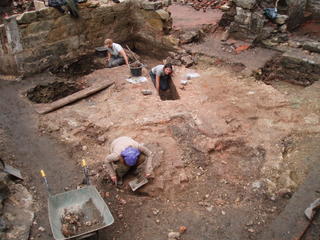Upper Coalbrookdale Landscape
 Detail of a 1759 engraving of the garden by Francois Vivares (IGMT Collections)
Detail of a 1759 engraving of the garden by Francois Vivares (IGMT Collections)Our work involved walkover survey, geophysical survey and excavation. Not only were we trying to establish the survival of remains associated with the eighteenth century garden, but we were also asking questions about its origin.
 Resistivity survey in progress - attempting to locate the southern wall.
Resistivity survey in progress - attempting to locate the southern wall.The excavation work looked at various components of the garden, and discovered previously unidentified elements of the walls and original paths. However the main focus was on the Summer House shown at the top of the garden in the engraving (above). We located the original eighteenth century building, and also discovered evidence for its modification in the nineteenth century.
 One of three trenches on the summer house site; original walls appear as infilled foundation trenches.
One of three trenches on the summer house site; original walls appear as infilled foundation trenches.Further work on this site will be undertaken next year, and we will be seeking volunteers to work on the project. Please email us for further information.
 The 2005 season was the third involving collaboration between the
The 2005 season was the third involving collaboration between the  Phase 2 - The malthouse. From the late 17th century the site underwent a few changes in ownership and design. By the 1730s the steel furnace had been demolished and the buildings surrounding it adapted for use as a malthouse. Here barley was soaked, sprouted and dried as preparation for use in brewing. We found settling tanks, the base of the kiln, and several varieties of drying floor tiles.
Phase 2 - The malthouse. From the late 17th century the site underwent a few changes in ownership and design. By the 1730s the steel furnace had been demolished and the buildings surrounding it adapted for use as a malthouse. Here barley was soaked, sprouted and dried as preparation for use in brewing. We found settling tanks, the base of the kiln, and several varieties of drying floor tiles.
